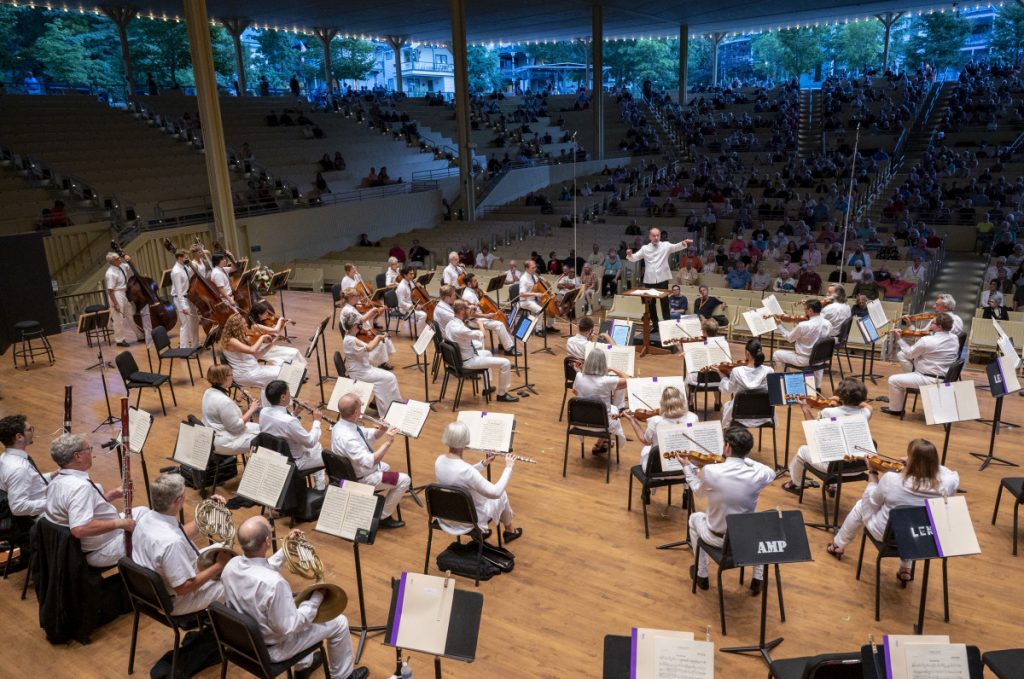NICHOLE JIANG – STAFF WRITER

Even though the Chautauqua Symphony Orchestra faced a shortened season and a smaller orchestra, from these challenges came opportunity — and tonight’s performance is a prime example. The wind section will take center stage at 8:15 p.m. Tuesday, Aug. 10 in the Amphitheater.
“It’s a very untypical season if you get two concerts for winds only and strings only,” said Eli Eban, clarinetist. “We’re overjoyed to be playing and that the concerts are going well. Although the breakdown in smaller ensembles which we normally don’t get to do is sort of a silver lining, because we play works that probably wouldn’t get to be featured.”
Due to a last-minute program change, there will be a small feature of strings in tonight’s performance.
The program will begin with the addition of Jessie Montgomery’s “Strum” for strings. The piece was originally scheduled to be performed on July 30. However, the postponed performance opened up the opportunity for the Chautauqua Diversity Fellows to perform the piece at tonight’s concert.
Though this is the first time Montgomery’s work will be performed at Chautauqua; her compositions have been performed by the San Francisco Symphony, Philadelphia Orchestra and the New York Philharmonic. Montgomery is the recipient of the Leonard Bernstein Musicianship Award, and the New York Philharmonic selected Montgomery as one of the composers for their Project 19.
Being able to feature Montgomery in tonight’s program is special, as female composers are at times overlooked, said Liana Kirvan, violinist.
“I’m very glad that more women composers are being performed,” Kirvan said. “(They) are not as often played, and I think that this should and will be changed in the near future with composers like Montgomery. The work we’re hearing from women composers is fantastic.”
“Strum” is filled with different rhythms and melodies that seem to take on a life of their own. The piece features a pizzicato element that adds extra texture and serves as the underlying rhythm throughout.
The program will continue as planned after the performance of “Strum,” with Mozart’s Wind Serenade in C Minor, K. 388 (384a) and Richard Strauss’ Suite in B-flat Major, Op. 4.
The Serenade in C Minor lets the audience experience a different side of Mozart, with its minor key and dark tones.
“Mozart usually writes in major keys with a few notable exceptions,” said Sean Gordon, bassoonist. “This C Minor key is very stormy and tumultuous, and so it’s a unique piece in that respect. It starts off really strongly with a big bold C Minor arpeggio. As far as Mozart goes, it’s a very dark piece, but at the same time it’s still got the playful characteristics of Mozart.”
The four-movement piece features clarinets, oboe, bassoon and horns with a special bassoon feature in the last movement.
“The last movement, which is really tricky, is a theme and variations,” Gordon said. “And toward the end, it has a really virtuosic 16th note with that rapid pace where bassoons will be playing. In this piece, there’s so much going on … for every instrument, and for the bassoon, than you’d typically hear in a full orchestra concert.”
The addition of the horns with the woodwind section adds a different texture and color that the audience normally wouldn’t get to experience in a full orchestral performance.
“The horn can kind of chameleon between the brass section in the woodwind section because it’s got that more mellow sound, and it really blends well and adds a lot of warmth into the woodwind sound that might be hard to get otherwise,” Gordon said. “The horns replacing the flutes in this performance gives it a little bit more balance between the uppers and lowers.”
The four-movement Strauss Suite in B Minor successfully features solos yet also blends the instruments together for a Romantic and expressive piece.
“It’s very contrapuntal, and it shows a lot of early Strauss and what’s to come,” Gordon said. “We’ll start with motives that will penetrate through the piece, and you’ll hear similar rhythms from one movement to another with similar note patterns and pitch patterns. And sometimes we’ll do them upside down, sometimes we’ll do them backwards. You might consciously notice that you’re basically listening to these microcosmic little things over and over again, and it’s really very characteristic of Strauss and what his later works will become.”
Following a dramatic first movement, the second movement, “Romanze,” features a clarinet solo. When it comes to the CSO, Music Director and Conductor Rossen Milanov allows the musicians their own freedom of artistic expression on stage.
“So in this case, the clarinet starts off with the suggestion of a phrase and the other instruments pick it up, so it’s like a dialogue,” Eban said. “We have Maestro Milanov, and he trusts his players to move with a certain amount of freedom. With a moment like this, I will be allowed to shape things the way I want. It’s a Romantic piece, early Strauss, and bittersweet in some ways — so that’s the approach I’ll try to take with sound and with phrasing.”
The musicians tonight are excited to have this opportunity to be on stage in an intimate setting performing pieces that they normally wouldn’t perform on the Amp stage.
“Each person has a more prominent role,” Gordon said. “I definitely feel like I’m creating a much bigger contribution to the whole ensemble, and any time that I have to play, I can be heard. Working more closely with my wind-playing colleagues to really explore those textures, I learn more about how to play with the section. We build more and more instincts for each other’s playing and we start to gravitate more toward each other artistically. And so these concerts, I think, really help us to create an even more captivating sound.”




